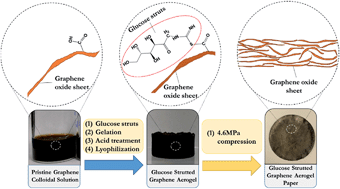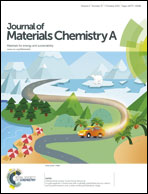Mechanically robust glucose strutted graphene aerogel paper as a flexible electrode†
Abstract
With the advent of next generation wearable technologies, energy storage devices at present not only have to achieve high energy densities they also need to possess reasonable mechanical robustness. Traditional graphene paper is mechanically robust which is ideal for a flexible electrode. However, the restacking issue and the degradation in performance with increasing thickness, limit the usage of graphene paper as a functional electrode. In this paper, porous, flexible, and free-standing graphene aerogel paper was prepared from an acid-treated glucose-strutted graphene aerogel via mechanical compression. The sulphur groups on the glucose struts served as a strengthening function due to thiol-carboxylic acid esterification and the increase in hydrogen bonding. The resulting nanostructured composite was able to exhibit a high ultimate tensile strength of 0.6 MPa which is 3 times that of the graphene aerogel paper without the glucose struts (0.2 MPa). It was also able to withstand 100 cyclic loadings of 0.13 MPa without failure. When electrochemically tested, it was able to discharge with a specific capacitance of 311 F g−1 at a current density of 1 A g−1, and a modest specific capacitance of 262 F g−1 at a high current density of 20 A g−1. Therefore, such results validate its promising application as a flexible electrode in energy storage devices.


 Please wait while we load your content...
Please wait while we load your content...